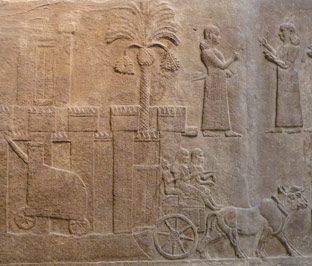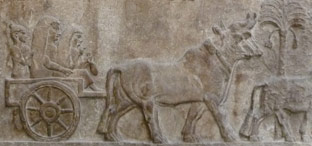Mass deportation: the Assyrian resettlement policy
The practice of resettling population groups was a key constituent of the structural set up of Ancient Near Eastern states, including the Assyrian Empire. This policy underpinned the high degree of cultural homogeneity and economic balance that characterised Assyria in the late 8th and the 7th centuries BC, despite the vast climatic and geographical differences within the region.
"By the rivers of Babylon"
The Bible contains a dark lament over the destruction of Jerusalem and the deportation of a sizeable portion of its inhabitants to southern Mesopotamia as a result of the capture of Judah's capital by the army of Nebuchadnezzar II, king of Babylon, in the year 586 BC:
"By the rivers of Babylon, there we sat down, and there we wept when we remembered Zion. On the willows there we hung up our harps. For there our captors asked us for songs, and our tormentors asked for mirth, saying, 'Sing us one of the songs of Zion!' But how could we sing the Lord's song in a foreign land? If I forget you, O Jerusalem, let my right hand wither! Let my tongue cling to the roof of my mouth, if I do not remember you, if I do not set Jerusalem above my highest joy!" (Psalm 137)
The Babylonian Captivity is not a unique case; it is one of many instances of the execution of the policy of enforced resettlement, by then well documented in the Ancient Near East for over two millennia. What makes it a special case is that we know about it from the point of view of those who were subjected to it and forced to leave their homes. But, as we shall see, the Bible also contains evidence that enforced resettlement could be seen as beneficial to those that were subjected to it.
Like a diligent gardener repotting his plants

Most Mesopotamian sources offer the perspective of the state which ordered the relocation. When relating their military victories in official inscriptions, rulers from the third millennium BC onwards habitually claimed to integrate defeated enemy armies and the inhabitants of subjugated cities and lands into their own realm. The vocabulary used is either that of violence and pillage, fittingly for the context of war, or that of a conscientious gardener, likening people to precious trees that are uprooted and replanted in the best possible circumstances. But how could enforced resettlement be perceived as positive for and by those affected by it?
When the Assyrian army laid siege to the city of Jerusalem in 701 BC during a campaign against the kingdom of Judah, the delegates of Sennacherib (704-681 BC) communicated a message to the people of Jerusalem, according to the Bible. After urging them not to support their own king who refused to submit to him, the Assyrian king promised: "Make your peace with me and come out to me! Then every one of you will eat of his own vine, and every one of you will eat of his own fig tree, and every one of you will drink the water of his own cistern, until I come and take you away to a land like your own land, a land of grain and wine, a land of bread and vineyards, a land of olive trees and honey, that you may live, and not die!" (2 Kings 18). Whether this quote is accurate or not, it is clear that what Sennacherib is said to have used in his attempt to ensnare the people of Jerusalem was the chance to be resettled elsewhere in the Assyrian Empire.
Deportation can indeed be regarded as a privilege rather than a punishment: people were not made to leave on their own but did so together with their families. They were not snatched away in the heat of battle or conquest, but were chosen as the result of a deliberate selection process, often in the aftermath of a war that had very possibly reduced their original home to ruins. And when the Assyrian sources specify who was to be relocated, they name the urban elites, craftsmen, specialists and scholars. These people were usually dispatched to the Assyrian heartland to generate knowledge and wealth. Hence, by the beginning of the 7th century BC, the central Assyrian cities of Nineveh, Kalhu and Assur housed experts from all over the known world. Without them, some of the most enduring achievements of the Assyrian kings, such as constructing and furnishing the magnificent palaces and temples or assembling the contents of the fabled library of Assurbanipal, would have been impossible.
Deporting political enemies
Forced resettlement could refer to very different scenarios. It is probably closest to our modern notion of a deportation when we read in an inscription of the Assyrian king Sargon II (721-705 BC) that in 720 BC he pardoned "6,300 guilty Assyrians" and had them settle in Hamat PGP , a city in Syria and formerly the capital of an eponymous kingdom which had been defeated and integrated into the Assyrian Empire some ten years before. During the tumultuous time of Sargon's ascent to the throne, the Assyrians in question had opposed his rise to power; after the struggle for control was decided in his favour, they had to be removed from the empire's power centre. Deporting them to Hamat achieved this, and by rebuilding the ruined but formerly important city, they were also meant to repay the mercy of their king, who could have had them executed for their disloyalty.
As we have seen, elites from newly subjugated areas were resettled in the Assyrian heartland to the economic and cultural benefit of the empire, and disgraced Assyrians were deported (rather than killed) in order to redeem themselves as colonists in the king's service. For all these people, relocation was meant to provide a better future while at the same time benefitting the empire, and not just economically. Of course, the relocation of these people was also an effective way of minimising the risk of rebellions and insurrections against central authority.
Improving the empire

The empire's profits were of paramount importance for a third type of deportation, which affected by far the largest number of people and transformed the Near East most profoundly: the intricate "colonisation" policy that was meant to make the most of the resources of the entire empire. Masterminded by the central administration, population groups from within the boundaries of the empire (and not just from recently subjugated enemy regions) were systematically moved around in order to achieve a variety of objectives, all of which had one thing in common: they were meant to provide stability to the empire - politically, structurally, economically and culturally.
While growing out of the customary integration of conquered armies and populations, the blueprint for these planned migrations was developed from the 9th century BC onwards and gained momentum in the second half of the 8th century BC, with the massive expansion of the Assyrian state which necessitated the integration of an area equal in size to that of the mother country. The organisation of the resettlement policy became one of the most important tasks of state and provincial administrators; in the course of the following centuries, population groups numbering in the hundreds of thousands, if not millions, were either transferred from one region to another or moved around in more convoluted patterns.
In keeping with the frequently employed gardening metaphors, which liken the deportees to valuable plants to be transferred to a new nurturing environment which they would in turn enrich, the primary objective was to relocate people in order to advance the agricultural infrastructure of the empire. They were to develop barren lands and to introduce to the Assyrian provinces new or hitherto neglected cultivation techniques, such as irrigation, beekeeping and the cultivation and production of flax, wine or oil. Those who worked the land assigned to them and paid taxes were the property's legal owners and, at least in the eyes of the state, the new arrivals were not treated any differently from those whose families had lived on their land for generations.
The implementation of the resettlement policy
The deportees, their labour and their abilities were extremely valuable to the Assyrian state, and their relocation was carefully planned and organised. We must not imagine treks of destitute fugitives who were easy prey for famine and disease: the deportees were meant to travel as comfortably and safely as possible in order to reach their destination in good physical shape. Whenever deportations are depicted in Assyrian imperial art, men, women and children are shown travelling in groups, often riding on vehicles or animals and never in bonds. There is no reason to doubt these depictions as Assyrian narrative art does not otherwise shy away from the graphic display of extreme violence, and contemporary text sources support the notion that the deportees were treated well, as attested for example in a letter from an Assyrian official to his king Tiglath-pileser III (744-727 BC):

"As for the Aramaeans about whom the king my lord has written to me: 'Prepare them for their journey!' I shall give them their food supplies, clothes, a waterskin, a pair of shoes and oil. I do not have my donkeys yet, but once they are available, I will dispatch my convoy." (NL 25 = SAA 19 17)
That the state continued to support the deportees once they had reached their destination is clear from another letter of the same author:
"As for the Aramaeans about whom the king my lord has said: 'They are to have wives!' We found numerous suitable women but their fathers refuse to give them in marriage, claiming: 'We will not consent unless they can pay the bride price.' Let them be paid so that the Aramaeans can get married." (NL 26 = SAA 19 18)
As we have seen, the Assyrian resettlement policy divided existing communities into those who had to stay and those who had to leave, according to the needs of the state. Populations were relocated within the boundaries of the empire, replacing and being replaced by people who were themselves moved. Our last source, especially, highlights that the state authorities actively encouraged a mixing of the new neighbours: the ultimate goal of the Assyrian resettlement policy was to create a homogeneous population with a shared culture and a common identity - that of "Assyrians".
Further reading
- Gallagher, 'Assyrian deportation propaganda', 1994.
- Na'aman and Zadok, 'Sargon II's deportations to Israel and Philistia', 1988.
- Postgate, 'The land of Assur and the yoke of Assur', 1992.
Content last modified: 5 Nov 2012.
Karen Radner
Karen Radner, 'Mass deportation: the Assyrian resettlement policy', Assyrian empire builders, University College London, 2012 [http://www.ucl.ac.uk/sargon/essentials/governors/massdeportation/]